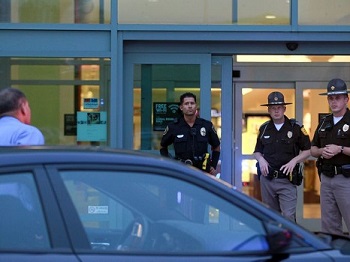Making sense?
There was a tragedy in my Midwestern town last night, the kind you may hear about (or not) on the national news. Senseless and brutal and worst of all, the same kind of thing we hear on the news almost every week. A security guard at the mall a few miles from here was fired from his job, went home for his gun, came back to the mall and shot a 20 year old woman three times in the back, and she died. He ran, but was caught a short time later on the freeway out of town. The story from a local radio station was that the woman reported him for sexually harassing her, that this led to his being fired, and that his Facebook page had a number of pro-gun postings.
“Humans, with our big ol’ brains” I tell students, “have to make sense of the world around us. We have to. We cannot walk around wondering ‘what just happened?’ or ‘why did he do that?’ We fit things we don’t understand into categories we already have, when we can – oh, that’s a thunderstorm. It’s a lunar eclipse. It’s adolescence, anything can happen.' When a catastrophe happens, by definition it doesn’t fit into a category and we have to figure out how to make sense of it.”
I tell them we have two primary ways of making sense: storytelling and theorizing. Some know right away that those two are really one, but depending on the course, I usually follow the line that they’re different things. Storytelling about the mall shooting is all over social media, and must be going on interpersonally as well: the parents who thought their child was at a movie with friends at that mall, and had a very bad few minutes until they found out she was at the other mall. The man in the food court who made eye contact with the gunslinger, and recognized him as the fired security guard, after the shots were fired and he ran for the door. All of us trying to grasp the fact that this happened here.
A theory of culture I draw upon often involves discursive force. It says (oversimplifying), that you know what cultural norms are by the ways people talk about actions related to those norms. I work to fit this theory around the security guard and his victim. He behaved in a way that she talked about as sexual harassment to someone who could, and did, fire his no-good ass. A norm of how male security guards speak to young women was violated, she spoke of it, her talk had consequences for him. He then went home, got a firearm that I have no doubt he was legally entitled to own and carry, probably concealed, into the public place where the young woman still was, shot her in the back three times and killed her.
Did he say something to her about the connection between her words and his actions, or just walk up and shoot?
Is the murder of a 20 year old woman who has complained about sexual harassment from a mall security guard a norm violation in this great land of ours? How will we know? Will it rest on whether you hear the story on your evening news, making it an event of national significance, or doesn’t go beyond our local news – where this will be the biggest headline all year?
Stories, theories, humans with great big brains. Talk all night, talk all month - it will still make no sense.
Commenting is not available in this channel entry.


Comments